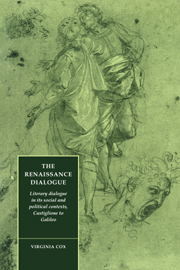 The Renaissance Dialogue
The Renaissance Dialogue Published online by Cambridge University Press: 05 December 2011
I will not here take notice of the several kinds of Dialogue, and the whole Art of it, which wou'd ask an entire Volume to perform. This has been a Work long wanted, and much desir'd, of which the Ancients have not sufficiently inform'd us; and I question whether any Man, now living, can treat it accurately.
John Dryden, Life of Lucian (1711)Three centuries after Dryden wrote this passage, the work he refers to is still ‘wanted’ and the chief obstacle which confronts the student of any of the ‘kinds’ of literary dialogue remains the lack of any substantial and coherent theoretical discussion of the genre. As Dryden notes, the Ancients – and most significantly Aristotle – gave little indication of what form such a theory might take, and subsequent critics have found themselves rather in the position of Northrop Frye's Renaissance doctors, who refused to take syphilis seriously because Galen had made no mention of it. For a brief period in the sixteenth century in Italy, when the vogue for the literary dialogue was at its height, there was a sustained attempt to bring the dialogue into the fold of Aristotelian genre criticism. But this initiative waned with the subsequent decline in the popular fortunes of the genre, and its provisional conclusion – that the dialogue was, in Tasso's formula, a fusion of dialectic and poetry – did not stand the dialogue in good stead in eras when poetry and non-poetry were ever more rigorously distinguished.
To save this book to your Kindle, first ensure [email protected] is added to your Approved Personal Document E-mail List under your Personal Document Settings on the Manage Your Content and Devices page of your Amazon account. Then enter the ‘name’ part of your Kindle email address below. Find out more about saving to your Kindle.
Note you can select to save to either the @free.kindle.com or @kindle.com variations. ‘@free.kindle.com’ emails are free but can only be saved to your device when it is connected to wi-fi. ‘@kindle.com’ emails can be delivered even when you are not connected to wi-fi, but note that service fees apply.
Find out more about the Kindle Personal Document Service.
To save content items to your account, please confirm that you agree to abide by our usage policies. If this is the first time you use this feature, you will be asked to authorise Cambridge Core to connect with your account. Find out more about saving content to Dropbox.
To save content items to your account, please confirm that you agree to abide by our usage policies. If this is the first time you use this feature, you will be asked to authorise Cambridge Core to connect with your account. Find out more about saving content to Google Drive.